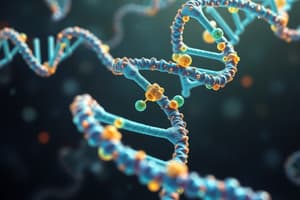Podcast
Questions and Answers
What is the sugar component present in DNA?
What is the sugar component present in DNA?
- Galactose
- Ribose
- Fructose
- Deoxyribose (correct)
Which of the following base pairs are correctly matched in the DNA double helix?
Which of the following base pairs are correctly matched in the DNA double helix?
- Adenine pairs with Uracil, Guanine pairs with Cytosine
- Adenine pairs with Cytosine, Guanine pairs with Thymine
- Adenine pairs with Thymine, Guanine pairs with Cytosine (correct)
- Adenine pairs with Guanine, Thymine pairs with Cytosine
Which of the following RNA types is responsible for carrying the genetic information from the nucleus to the cytoplasm for protein synthesis?
Which of the following RNA types is responsible for carrying the genetic information from the nucleus to the cytoplasm for protein synthesis?
- Small interfering RNA (siRNA)
- Messenger RNA (mRNA) (correct)
- Transfer RNA (tRNA)
- Ribosomal RNA (rRNA)
What is the primary function of transfer RNA (tRNA) in the process of protein synthesis?
What is the primary function of transfer RNA (tRNA) in the process of protein synthesis?
What is the process by which the genetic information stored in DNA is transcribed into RNA?
What is the process by which the genetic information stored in DNA is transcribed into RNA?
Which of the following statements about DNA and RNA is correct?
Which of the following statements about DNA and RNA is correct?
What is the primary function of the genetic code?
What is the primary function of the genetic code?
Which of the following statements about translation is incorrect?
Which of the following statements about translation is incorrect?
What is the primary function of RNA polymerase during transcription?
What is the primary function of RNA polymerase during transcription?
Which of the following is not a type of RNA involved in gene expression?
Which of the following is not a type of RNA involved in gene expression?
What is the primary function of tRNA during translation?
What is the primary function of tRNA during translation?
What is the significance of the promoter region in transcription?
What is the significance of the promoter region in transcription?
Flashcards are hidden until you start studying
Study Notes
Nucleic Acids: Structure, Function, and Processes
Nucleic acids are essential macromolecules responsible for storing and transmitting genetic information within cells. They play a vital role in determining the inherited traits of all living organisms through the process of protein synthesis. There are two primary classes of nucleic acids: deoxyribonucleic acid (DNA) and ribonucleic acid (RNA). Both DNA and RNA consist of nucleotides, the building blocks of nucleic acids. These molecules contain nitrogen-containing bases, sugars, and phosphate groups.
DNA Structure
Deoxyribonucleic acid, commonly known as DNA, is composed of two long, complementary strands twisted around each other to form a double helix. Each strand is made up of nucleotides containing the bases adenine (A), guanine (G), cytosine (C), and thymine (T). The sugar in DNA is deoxyribose, which lacks the hydroxyl group (-OH) on the 2' carbon of the sugar ring compared to the sugar in RNA. This difference in sugar structure helps distinguish between DNA and RNA.
RNA Types
Ribonucleic acid, or RNA, comes in various forms depending on their function. Messenger RNA (mRNA), transfer RNA (tRNA), ribosomal RNA (rRNA), microRNA (miRNA), and small interfering RNA (siRNA) are some examples of RNA species. While DNA is mostly stable and resistant to changes, RNA is more dynamic and can be modified, processed, and turned over more rapidly.
Genetic Code
The genetic code is the sequence of codons, triplets of nucleotides, that specifies amino acids in protein sequences. The standard genetic code defines sets of 64 codons, which correspond to the 20 amino acids used in protein synthesis. DNA replicates this code through transcription, which involves copying genetic information from DNA to RNA.
Translation
Translation is the process by which cells use the genetic code stored in nucleic acids to assemble proteins. It involves two main steps: transcription and translation itself. In transcription, the genetic information encoded in DNA is transcribed into mRNA using an enzyme called RNA polymerase. The mRNA then travels out of the cell's nucleus to the cytoplasm, where it is read by ribosomes. Within ribosomes, the transfer RNA (tRNA) molecules recognize codons on the mRNA and link them with amino acids according to the genetic code.
Transcription
Transcription is the process by which genetic information is copied from DNA to RNA, forming messenger RNA (mRNA). This process occurs within the cell's nucleus, where DNA is located. Transcription begins when an enzyme called RNA polymerase binds to a specific region of DNA, called a promoter, initiating the unzipping of the DNA double helix. As the DNA strands separate, one of them acts as a template for RNA synthesis. Nucleotides are assembled in a continuous chain, following the base pairing rules (A pairs with T, and G pairs with C). When transcription is complete, the resulting mRNA molecule is released from the DNA template and transported out of the nucleus to the cytoplasm, where translation occurs.
Studying That Suits You
Use AI to generate personalized quizzes and flashcards to suit your learning preferences.




